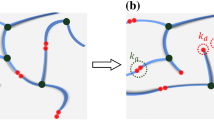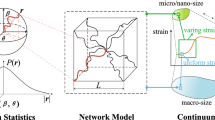Abstract
The “constrained-chain” theory of rubber elasticity proposed by Crossland and van der Hoff was found by them to predict quantitatively many salient features of experimental studies.
The present work utilized the “constrained-chain” strain-energy function in a development parallel to that of the “rubberlike liquid” model of Lodge to arrive at a naturally strain-dependent integral constitutive equation for viscoelastic fluids. It can be considered as a particular case of theK-BKZ model with part of the memory function arising from a molecular model. The memory function contains the only nonlinear parameter of the model, the maximum extensibility of a network chain. The model gives a singularity in the stress integral when a network chain is streched to its maximum extensibility. To eliminate this singularity, an assumption has been made which reduces the number of fully extended network chains to zero. Alternative approaches are discussed briefly.
Similar content being viewed by others
References
Lodge, A.S., Elastic Liquids, Academic Press (New York, 1964)
Lodge, A.S., Rheol. Acta7, 379 (1968)
Kaye, A., Brit. J. Appl. Phys.17, 803 (1966)
Tanner, R.I., J.M. Simmons, Chem. Eng. Sci.22, 1803 (1967)
Yamamoto, M., Appl. Polym. Symp.20, 3 (1973)
Wagner, M.H., Rheol. Acta15, 136 (1976)
Spriggs, T.W., J.D. Huppler, R.B. Bird, Trans. Soc. Rheol.10, 191 (1966)
Bird, R.B., P.J. Carreau, Chem. Eng. Sci.23, 427 (1968)
Carreau, P.J., Trans. Soc. Rheol.16, 99 (1972)
Treloar, L.R.G., The Physics of Rubber Elasticity, 3rd Ed., Oxford University Press (London, 1975)
Crossland, A.H., B.M.E. van der Hoff, J. Macro. Sci.-Chem.A10, 825 (1976)
Dusek, K., W. Prins, Advan. Polym. Sci.6, 1 (1969)
Chan, T.W., I.F. Macdonald, Rheol. Acta22 361 (1983)
Chan, T.W., Ph.D. Thesis, University of Waterloo, Waterloo, Ontario, 1982
Rivlin, R.S., Large Elastic Deformations, in: F.R. Eirich (ed.) Rheology, Vol.1, Chapter 10, Academic Press (New York, 1956)
Bird, R.B., C. Hassager, R.C. Armstrong, C.F. Curtiss, Dynamics of Polymeric Liquids, Vol. II, Kinetic Theory, Wiley (New York, 1977)
Rouse, P.E., J. Chem. Phys.21, 1272 (1953)
Lodge, A.S., Trans. Faraday Soc.52, 120 (1956)
Yamamoto, M., J. Phys. Soc. Japan11, 413 (1956);12, 1148 (1957);13, 1200 (1958)
Tanner, R.I., A.I.Ch.E.J.15, 177 (1969)
Kaye, A., College of Aeronautics Note No. 134, Cranfield, England, 1962
Bernstein, B., E.A. Kearsley, L.J. Zapas, Trans. Soc. Rheol.7, 391 (1963)
Wagner, M.H., S.E. Stephenson, J. Rheol.23, 489 (1979)
Wagner, M.H., S.E. Stephenson, Rheol. Acta18, 463 (1979)
Laun, H.M., Rheol. Acta17, 1 (1978)
Osaki, K., S. Ohta, M. Fukuda, M. Kurata, J. Polym. Sci.14, 1701 (1976)
Wagner, M.H., Rheol. Acta18, 33 (1979)
Tanner, R.I., Trans. Soc. Rheol.12, 155 (1968)
Takahashi, M., T. Masuda, S. Onogi, J. Soc. Rheol. Japan1, 16 (1973)
Author information
Authors and Affiliations
Additional information
This paper is dedicated to Alan H. Crossland whose “constrained-chain” theory of rubber elasticity provides the foundation for the work presented here. His untimely death at the age of 38 is a tragic loss for his family, for those of us who knew him as a colleague and for the field of polymer rheology which has lost a gifted researcher.
Rights and permissions
About this article
Cite this article
Chan, T.W., Macdonald, I.F. A “constrained-chain” network model for viscoelastic fluids. Rheol Acta 22, 354–360 (1983). https://doi.org/10.1007/BF01333765
Received:
Revised:
Issue Date:
DOI: https://doi.org/10.1007/BF01333765




